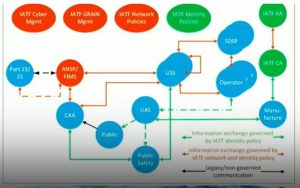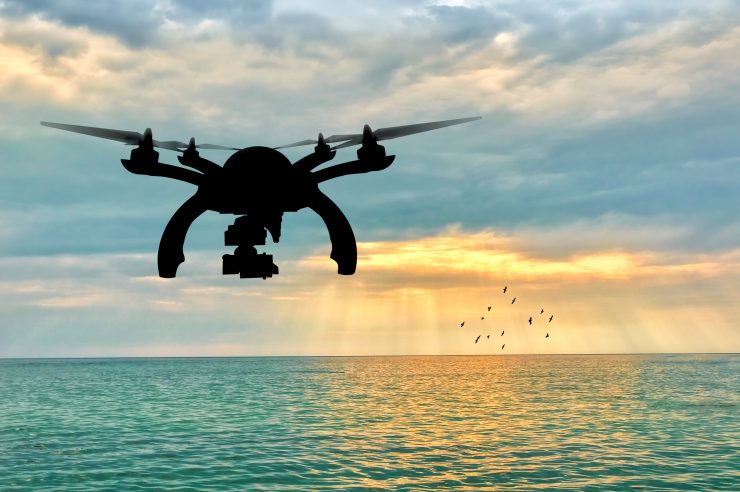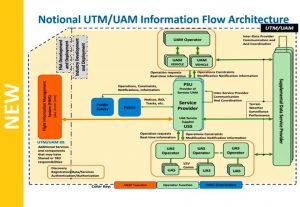How to apply the Global Aviation Trust Framework under development by the International Civil Aviation Organisation (ICAO) to the global UAS traffic management industry – so drone operator identities can be shared safely among regulators in different countries, for example – was one of the key discussion points at this week’s DroneEnable3 event in Montreal.
The aim of the ICAO global aviation trust framework (IATF) is to provide a high-level globally inter-operable architecture to manage the vast number of new aviation entrants – such as drone operators – while helping to protecting communication links between UTM and ATM systems from cyber threats. There is a growing realisation across the industry that a global digital trust framework could be vital enabler to meeting these two challenges.
“The concept of a digital identity is a non-brainer,” said Reinaldo Negron, Co President (Wing) at the Global UTM Association (GUTMA). It is the key to enabling inter-operable APIs and standards. GUTMA is planning to form a registration inter-operability working group, which will include civil aviation authorities, ICAO, industry, telecommunications companies and other stakeholders as a step towards harmonising national approaches to drone and drone operator registration.
Meanwhile the Federal Aviation Administration (FAA) is developing a new concept of ATM/UTM integration, using a digital trust framework. When you have, in effect, multiple air navigation services providers managing potentially millions of drones in a UTM system then you will need a new type of communications concept to handle those transactions and interface with legacy ATM systems, according to Robert Segers, NextGen ISS architect at the FAA. He showed delegates how a possible IATF-communications protocol could be used as a possible communications link between the UTM and ATM infrastructures (see below).

There was other significant UTM news from event. ICAO has launched the second edition of its UTM framework document – available on the ICAO website at https://www.icao.int/safety/UA/Documents/UTM-Framework%20Edition%202.pdf – as an update to the first edition published in April 2019. It outlines the core capabilities of a typical UTM network and edition two includes new guidance material on ATM/UTM boundaries, the transitions between them and the exchange of information required for successful integration. A third edition is under development, according to ICAO Mark Wuennenberg, Technical Officer RPAS section
Meanwhile SESAR’s Executive Director Florian Guillermet outlined a number of technical and procedural uncertainties that remain following the recent network of U-Space demonstrator trials. Among them are certifying aircraft flying over densely populated areas, problems of scaling up services and difficulties in developing standardised procedures in separation management at part of the U-Space concept of operations.
Cristiano Baldoni, CEO of Italy’s national UTM service provider D-Flight underlined the importance of national defence departments in developing airspace management programmes at all levels of flight. He told delegates that U-space is part of a much larger value chain – and that the debate about whether it should be designed as a centralised or decentralised service might best be resolved at State level, although a centralised approach would work for a small set of regulated services. D-Flight, said Cristiano Baldoni, was currently considering letting industry manage the development and deployment of the “UTM box”, the on-board communications equipment, used to track drone movements (https://www.unmannedairspace.info/uncategorized/enav-estimates-eur-75-million-utm-income-2028/) rather than leaving this with the UTM company.
Meanwhile Benoit Curdy of the Digital Transformation unit at the Federal Office of Civil Aviation Switzerland told delegates that remote identification of drone services will become operational in Switzerland in 2020, with UTM service providers required to adopt ASTM standard connections to manage and share remote flight data.
| FAA and NASA’s UTM concept “expanded to include urban air mobility”
The scope of UTM in the Federal Aviation Administration’s concept of operations is now being expanded to accommodate Urban Air Mobility (UAM) operations, according to UTM industry specialist Paul Pocialik. Based on a new UTM/ATM architecture revealed in a presentation by Steve Bradford, FAA Chief Scientist delivered at Drone Enable3 2019, Paul Pocialik writes in a LinkedIn post: “This is significant but shouldn’t come as a surprise since it has been telegraphed by NASA and the FAA for a while now. Even so, there has been little in the way of documentation or plans released on how this could be engineered from a system architecture perspective. So now we know. I personally think this is great. It shows how our original investment in UTM as a digital alternative to traditional ATM can be increasingly leveraged to support new entrants in aviation.” |





